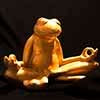American football culture is a unique phenomenon of U.S. The game originates from Rugby and has evolved over the last 100 years to its current form. Players actually have not been using their feet all that much beyond running since forward pass from anywhere behind the line of scrimmage was allowed in 1933, The game is played by kids as young as 5 years old (see e.g. Pop Warner) through college and universities. It also has a successful and highly profitable professional association NFL (National Football League) that is currently consisted of 32 teams across the country that are further divided into two conferences – AFC (American Football Conference) and NFC (National Football Conference). Each conference has four 4-team divisions (North, East, South and West). Depending on the measure you use, it can be considered the most popular sport in America with stadiums of capacity ranging from approximate 50 thousands to almost 90 thousands seats. It is a huge commercial business; each team is valued at about $0.5-1B with Television Networks bidding and paying over $3B annually in total to gain just the rights to broadcast NFL games alone. It is certainly one of the most watched entertainment programs on TV!
I got curious and became interested in watching American football games while I was attending the graduate school. Living near the U.C. Berkeley football stadium and many fraternity houses during my first year in U.S., one can’t help but noticing the noises, the crowds and parties from the neighborhoods before, during, and after the Saturday games through the fall. Media coverage of the legendary NFL Oakland Raiders of the 70’s at the next door certainly helped to generate further interest with a sense of association by proximity. After moving to the east coast, cheering for the “home town” San Francisco 49ers led by Bill Walsh and Joe Montana was a no-brainer in the 80’s as it would give some bragging rights in sports conversations by default.
Make no mistakes, professional American football is the ultimate capitalism sport and is not for faint hearted. It scales – up to 90 thousand fans physically in the stadium plus millions in front of the TV. It epitomizes the ultimate industrialization of the society: specialization of the functions and tight integration through sophisticated processes and peripherals together produce an extremely efficient cartel. The player functions and positions are divided into offense, defense, and special units which are played at different circumstances. Offense is made up with 11 players in 5 distinct roles – Offensive Line, Quarterback, Running Backs, Wide Receivers, and Tight Ends. Defense is made up with 11 players in 3 roles – Defensive Line, Line Backers, and Defensive Backs (Corner Backs or Safeties). On the other hand, the special team has jobs like Kicker, Holder, Kick Returner, Punter, etc. to handle everything else beyond the offense/defense units duels. Players are tested, drafted, recruited, traded, groomed, and placed into particular positions competitively depending on how close an individual approximates the optimal physical and mental characteristics of that particular position. You can get a feel for their amazing talents and capabilities by watching a part of the CBS 60 Minutes interview with San Diego Charger’s LaDainian Tomlinson, a superstar Running Back.
Of course, having a bunch of super athletes optimized for each position is not sufficient by itself. Strategies, creativities, and executions with rigorous practices is crucial as well. It is not unusual that each team’s playbook has tens or hundreds of plays, completed with high tech and back up storage and communication devices. The goal of the team is simple enough – moving down the field towards to opponent’s end zone to score more points than the opponent before the end of the game, by touch down/conversion, field goal, or touch back.
Professional American football is in some ways the modern day Gladiator entertainment – win or die if you are a player, cheers/boos and bet if you are a spectator. The average weight and height of NFL players today is about 250 lbs and over 6 ft with offensive lineman on the high side, average over 300 lbs and 6’3’’. It is a collision sport with extremely physical force – hitting each other is a part of the game and you can almost hear the bone crushing sound in some of the contacts. LaDainian Tomlinson mentioned in his interview that (as a running back) playing a game is equivalent to experiencing through a car wreck. The NFL player career length averages is about 3.5 seasons with an average annual salary of about $1M with a large variance.
Over a decade ago, I had chances to be at the 80 thousand seats New York Giant Stadium (which is physically in New Jersey, go figure!) for kids’ high school events. The feeling was surreal: as I stood in the field and looked up to the voluminous bowl shaped seats, I suddenly realized the 120 yards by 50+ yards football field is much bigger than you see through TV cameras or the cheaper seats up in the stadium, and yet at the same time, I felt I was much bigger than my actual physical size. Only then I began to appreciate and could imagine how the players (and for the matter, the gladiators two thousand years ago) might be feeling emotionally when over 50 thousand fans stand on their feet and cheer on thunderously off the top of their lungs.
This season’s NFL Super Bowl XLII will be kicked off at 6:20 p.m. EST in Arizona on Sunday Feb 3rd. New England Patriots will beat New York Giants 38 to 20 to complete its undefeated season, 2nd time in NFL history after the 1972 Miami Dolphins. Two days later, on the Super Tues Feb 5th, voters from 24 states across U.S. will be having primaries and caucuses to choose their Republican and Democrats presidential candidates. The Results? Too close to call for Democrats but John McCain will win Republicans’.
Talk to you soon!








